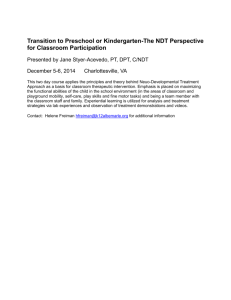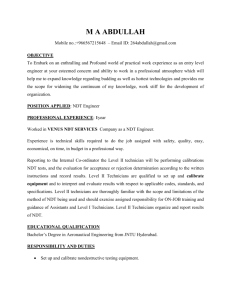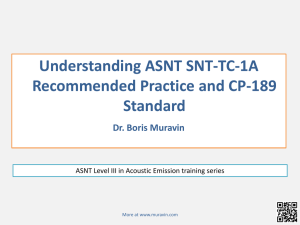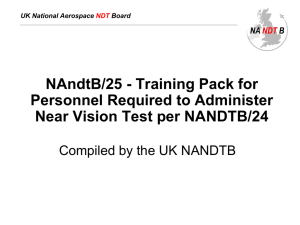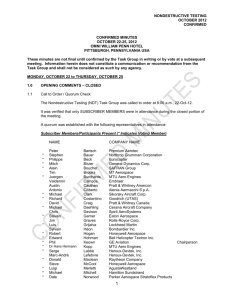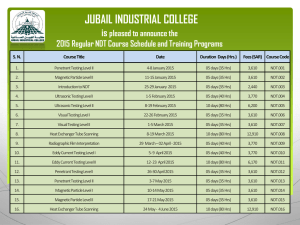UK National Aerospace NDT Board
advertisement
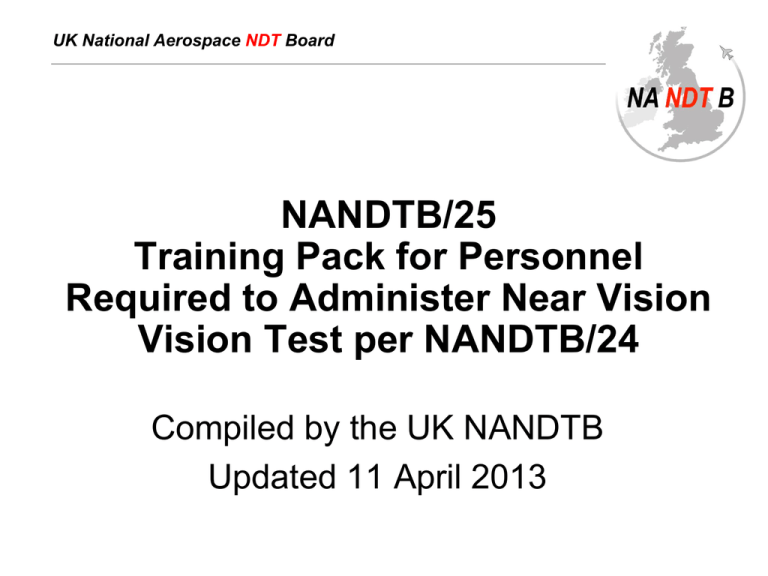
UK National Aerospace NDT Board NANDTB/25 Training Pack for Personnel Required to Administer Near Vision Vision Test per NANDTB/24 Compiled by the UK NANDTB Updated 11 April 2013 2 Background EN4179:2005 required near vision acuity to Jaeger No 1 or equivalent, not less than 30 cm/12 in in at least one eye, natural or corrected. Vision acuity in EN4179:2009 changed to 20/25 (Snellen) at 16" (42 cm) +/- 1" (2.54 cm) or equivalent in at least one eye, natural or corrected. There are methods other than Snellen for examining near vision eyesight acuity and there is considerable debate even within the medical field as to ‘equivalency’ of vision requirements. Responsible Level 3s will find it difficult to obtain clearly defined supporting medical evidence regarding the equivalency of vision requirements. The numerous potential avenues for equivalency provides scope for variation and error. UK National Aerospace NDT Board 3 Compliance (pre 2011) EN4179/NAS410 20/25 (Snellen) @ 16” +/- 1” Acceptable Equivalents Jaeger Chart Point Chart #1 @ ≥12” N4 @ ≥16” FAA 8500-1 Potential Others Other ‘Snellen’ 16” charts BS4274-1 (2003) ISO8596 (2009) Sloan Characters ‘Sans Serif’ font UK National Aerospace NDT Board Distance reading standards Not suitable for near vision 4 Global Standard An agreed global standard for NDT personnel would eliminate the problems of variation and mitigate the risk of error. A standardised solution is required taking the following essential attributes in to consideration: Optotype Optotype size based upon 5 minutes of arc Optotype spacing Eye to optotype distance Illumination Acceptance criteria Use of both eyes (as used for inspection) Optotype = the E shaped character of defined proportions and of various sizes that are used to verify near vision acuity UK National Aerospace NDT Board UK NANDTB Policy Single Option - Visual acuity tests to be carried out: Using the UK NANDTB chart and NANDTB/24 Using the actual eye wear used in the inspection process Note: This includes corrective lenses and/or eye protection as normally used. “Equivalents” not permitted within UK jurisdiction Existing certification valid until expiration Responsible Level 3 accountable for training and delegations Note: No Medical/Optical alternative test permitted (eg Optometrist Standard tests) Functional NEAR VISION Acuity Test Not for colour vision Not medical examination Employers should consider this separately – as for VDU operators etc UK National Aerospace NDT Board 5 6 EN4179 7.1.1 Vision The vision examination for trainee, Level 1-Limited, Level 1, Level 2, and Level 3 personnel shall assure that the applicant’s near vision and colour perception meet the requirements of Table 5. Vision requirements do not apply to instructors or auditors. Near vision tests shall be administered annually and colour perception tests shall be administered at least every five years. The employer shall ensure the flow-down of the Table 5 vision requirements to all necessary personnel and/or facilities. These tests shall be administered by trained personnel designated by the Responsible Level 3 or by qualified medical personnel. When vision correction is necessary to pass the visual acuity exam, vision correction shall be worn during all testing/inspections. Any limitations in colour perception shall be evaluated by the Responsible Level 3 prior to certification and must be approved in writing. Table 5 — Vision requirements Examination Requirements Near Vision - 20/25 (Snellen) at 16" (42 cm) ± 1" (2,54 cm) or equivalent a in at least one eye, natural or corrected. Colour Perception - Personnel shall be capable of adequately distinguishing and differentiating colours used in the process involved. Equivalency to be determined by the Responsible Level 3. UK National Aerospace NDT Board 7 UK NANDTB Advisory AD002 (iss 2) Action: The Tumbling E NDT near vision acuity test is downloadable via the UK NANDTB website. http://www.bindt.org/NANDTB The controlling procedure, NANDTB-24, which defines how the test shall be administered and by whom is also available via the UK NANDTB website. This test is deemed by the UK NANDTB as equivalent to the requirements of EN4179 (and NAS410). This test maybe used with immediate effect. Employer written practices and/or procedures need to be revised to recognise the application of this NDT near vision acuity test. As of 1st January 2011, application of this near vision acuity test to NDT personnel under UK jurisdiction will be mandatory. No other equivalents will be permitted. UK National Aerospace NDT Board 8 <Insert what your written practice states> 3. UK National Aerospace NDT Board 9 www.bindt.org UK NANDTB PAGES UK National Aerospace NDT Board 10 UK National Aerospace NDT Board 11 UK National Aerospace NDT Board 12 UK National Aerospace NDT Board 13 UK National Aerospace NDT Board 14 UK National Aerospace NDT Board 15 UK National Aerospace NDT Board 16 Salient Points Failure to meet the defined level of acuity, in some cases, may be due to the quality of the test chart produced. Care should be exercised to ensure that the quality of the test chart is appropriate and where personnel fail to meet the required level the quality of the chart should be reviewed before declaring an individual has inadequate near vision. Personnel shall be adequately trained before administering this test. Training and delegation of personnel authorised to conduct tests shall be the responsibility of the Responsible Level 3. Such nominations shall be made in writing and form part of the formal records for that individual. Medical personnel including Optometrists are not exempt from this requirement. The two blocks of optotypes (Annex A) have been developed to accommodate the different types of printing equipment commonly encountered. The block which prints best shall be used. The annotated 250mm distance between the defined marks shall be measured and shall not be less than 245mm nor more than 255mm. The charts are generated randomly. Visible, white light of 500 ±200 lux shall be used to illuminate the chart. The chart shall be positioned on a flat surface and the candidate shall move towards the chart to the test distance of 400 ±25 mm. Candidates shall wear the same eyewear, if any, as used during routine NDT inspection. This may be personal protective equipment and/or corrective lenses. It is expected that the candidate will be able to identify the orientation of each of the individual optotypes. “UP, DOWN, LEFT and RIGHT” or similar. UK National Aerospace NDT Board 17 UK National Aerospace NDT Board 18 UK National Aerospace NDT Board 19 UK National Aerospace NDT Board 20 The test The test shall not be limited to a test of an individual eye. Both eyes shall be used together as for normal NDT inspection. The examiner will have established which of the two blocks of optotypes are to be administered as the test and the chart may optionally be identified by a pen line through the redundant block. The candidate shall identify the characters starting from the left side of line 1 moving to the right until a response is given for each of the 5 characters. This shall be repeated for lines 2 onwards until the candidate reaches the limit of their capability. The examiner should prepare a results sheet in advance or record the candidate’s response in a manner that allows verification of correctness. Near vision acuity is considered acceptable where the candidate correctly identifies all the individual optotypes (5 out of 5 on each line) for lines 1 to 9 inclusive. Where a candidate fails to achieve this the examiner shall verify that the test chart or test conditions were not the cause of failure before sending the candidate for further tests for corrective lenses or a more comprehensive assessment of near vision acuity. UK National Aerospace NDT Board 21 Record Use eyesight test record card Alternatively, the actual vision chart used maybe maintained as the record along with the following: UK National Aerospace NDT Board Name of individual Check number Dept No Date of Birth Date tested Optical aids worn during test Acuity level achieved Name/signature of trained and approved administrator 22 Benefits Is Universal - No language/alphabet dependency Based on vision acuity – not reading ability Based on resolution of 6 mins of arc - as 20/25 Snellen Can be administered locally Directly controlled by Responsible Level 3 Basically “fail safe” Administered under defined conditions Auditable Based on accepted scientific principles (eg BS 4274-1, ISO 8596) Can be carried out in inspection area May be carried out in conjunction with annual performance review UK National Aerospace NDT Board
